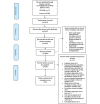Effectiveness of Public Health Digital Surveillance Systems for Infectious Disease Prevention and Control at Mass Gatherings: Systematic Review
- PMID: 37204833
- PMCID: PMC10238952
- DOI: 10.2196/44649
Effectiveness of Public Health Digital Surveillance Systems for Infectious Disease Prevention and Control at Mass Gatherings: Systematic Review
Abstract
Background: Mass gatherings (MGs; eg, religious, sporting, musical, sociocultural, and other occasions that draw large crowds) pose public health challenges and concerns related to global health. A leading global concern regarding MGs is the possible importation and exportation of infectious diseases as they spread from the attendees to the general population, resulting in epidemic outbreaks. Governments and health authorities use technological interventions to support public health surveillance and prevent and control infectious diseases.
Objective: This study aims to review the evidence on the effectiveness of public health digital surveillance systems for infectious disease prevention and control at MG events.
Methods: A systematic literature search was conducted in January 2022 using the Ovid MEDLINE, Embase, CINAHL, and Scopus databases to examine relevant articles published in English up to January 2022. Interventional studies describing or evaluating the effectiveness of public health digital surveillance systems for infectious disease prevention and control at MGs were included in the analysis. Owing to the lack of appraisal tools for interventional studies describing and evaluating public health digital surveillance systems at MGs, a critical appraisal tool was developed and used to assess the quality of the included studies.
Results: In total, 8 articles were included in the review, and 3 types of MGs were identified: religious (the Hajj and Prayagraj Kumbh), sporting (the Olympic and Paralympic Games, the Federation International Football Association World Cup, and the Micronesian Games), and cultural (the Festival of Pacific Arts) events. In total, 88% (7/8) of the studies described surveillance systems implemented at MG events, and 12% (1/8) of the studies described and evaluated an enhanced surveillance system that was implemented for an event. In total, 4 studies reported the implementation of a surveillance system: 2 (50%) described the enhancement of the system that was implemented for an event, 1 (25%) reported a pilot implementation of a surveillance system, and 1 (25%) reported an evaluation of an enhanced system. The types of systems investigated were 2 syndromic, 1 participatory, 1 syndromic and event-based, 1 indicator- and event-based, and 1 event-based surveillance system. In total, 62% (5/8) of the studies reported timeliness as an outcome generated after implementing or enhancing the system without measuring its effectiveness. Only 12% (1/8) of the studies followed the Centers for Disease Control and Prevention guidelines for evaluating public health surveillance systems and the outcomes of enhanced systems based on the systems' attributes to measure their effectiveness.
Conclusions: On the basis of the review of the literature and the analysis of the included studies, there is limited evidence of the effectiveness of public health digital surveillance systems for infectious disease prevention and control at MGs because of the absence of evaluation studies.
Keywords: digital surveillance system; infectious disease prevention and control; mass gathering event; public health; systematic review.
©Noha Maddah, Arpana Verma, Maryam Almashmoum, John Ainsworth. Originally published in the Journal of Medical Internet Research (https://www.jmir.org), 19.05.2023.
Conflict of interest statement
Conflicts of Interest: None declared.
Figures
Similar articles
-
Strengthening health security at the Hajj mass gatherings: characteristics of the infectious diseases surveillance systems operational during the 2015 Hajj.J Travel Med. 2017 May 1;24(3):taw087. doi: 10.1093/jtm/taw087. J Travel Med. 2017. PMID: 28355612 Free PMC article.
-
Public Health Threats in Mass Gatherings: A Systematic Review.Disaster Med Public Health Prep. 2019 Dec;13(5-6):1035-1046. doi: 10.1017/dmp.2018.161. Disaster Med Public Health Prep. 2019. PMID: 31250774
-
The Olympic and Paralympic Games 2012: literature review of the logistical planning and operational challenges for public health.Public Health. 2008 Nov;122(11):1229-38. doi: 10.1016/j.puhe.2008.04.016. Epub 2008 Jul 11. Public Health. 2008. PMID: 18619630 Review.
-
Syndromic surveillance during religious mass gatherings, southern India 2015-2018.Travel Med Infect Dis. 2022 May-Jun;47:102290. doi: 10.1016/j.tmaid.2022.102290. Epub 2022 Mar 3. Travel Med Infect Dis. 2022. PMID: 35247579
-
London 2012 Olympic and Paralympic Games: public health surveillance and epidemiology.Lancet. 2014 Jun 14;383(9934):2083-2089. doi: 10.1016/S0140-6736(13)62342-9. Epub 2014 May 20. Lancet. 2014. PMID: 24857700 Free PMC article. Review.
Cited by
-
Viral co-detection of influenza virus and other respiratory viruses in hospitalized Brazilian patients during the first three years of the coronavirus disease (COVID)-19 pandemic: an epidemiological profile.Front Microbiol. 2024 Oct 16;15:1462802. doi: 10.3389/fmicb.2024.1462802. eCollection 2024. Front Microbiol. 2024. PMID: 39479210 Free PMC article.
-
Global distribution and health impact of infectious disease outbreaks, 1996-2023: a worldwide retrospective analysis of World Health Organization emergency event reports.J Glob Health. 2025 May 16;15:04151. doi: 10.7189/jogh.15.04151. J Glob Health. 2025. PMID: 40375732 Free PMC article.
-
Challenges and opportunities of artificial intelligence in African health space.Digit Health. 2025 Jan 21;11:20552076241305915. doi: 10.1177/20552076241305915. eCollection 2025 Jan-Dec. Digit Health. 2025. PMID: 39839959 Free PMC article.
-
Spatial autocorrelation of environmental factors influencing dengue outbreaks using Moran's I: A study from Nepal (2020-2023).PLoS One. 2025 Jun 4;20(6):e0324798. doi: 10.1371/journal.pone.0324798. eCollection 2025. PLoS One. 2025. PMID: 40465649 Free PMC article.
-
Development of a data-driven urban immunity assessment model: providing a new benchmark for urban governance under public health emergencies.Front Public Health. 2025 May 29;13:1609641. doi: 10.3389/fpubh.2025.1609641. eCollection 2025. Front Public Health. 2025. PMID: 40510575 Free PMC article.
References
-
- Choi J, Cho Y, Shim E, Woo H. Web-based infectious disease surveillance systems and public health perspectives: a systematic review. BMC Public Health. 2016 Dec 08;16(1):1238. doi: 10.1186/s12889-016-3893-0. https://bmcpublichealth.biomedcentral.com/articles/10.1186/s12889-016-38... 10.1186/s12889-016-3893-0 - DOI - DOI - PMC - PubMed
-
- Abat C, Chaudet H, Rolain JM, Colson P, Raoult D. Traditional and syndromic surveillance of infectious diseases and pathogens. Int J Infect Dis. 2016 Jul;48:22–8. doi: 10.1016/j.ijid.2016.04.021. https://linkinghub.elsevier.com/retrieve/pii/S1201-9712(16)31038-4 S1201-9712(16)31038-4 - DOI - PMC - PubMed
-
- Morens DM, Folkers GK, Fauci AS. The challenge of emerging and re-emerging infectious diseases. Nature. 2004 Jul 08;430(6996):242–9. doi: 10.1038/nature02759. https://europepmc.org/abstract/MED/15241422 nature02759 - DOI - PMC - PubMed
Publication types
MeSH terms
LinkOut - more resources
Full Text Sources
Medical


